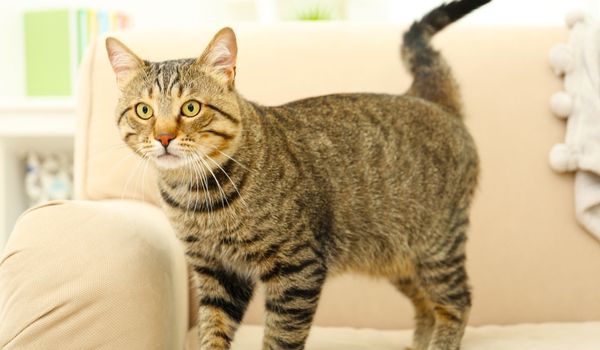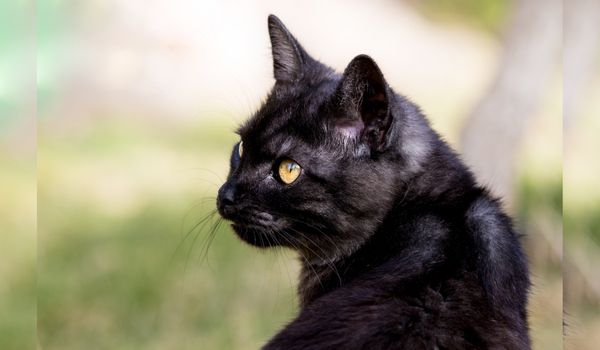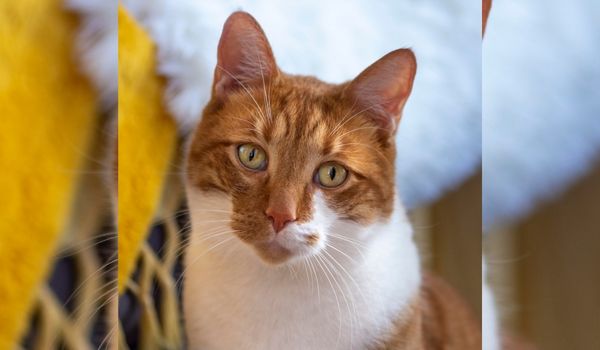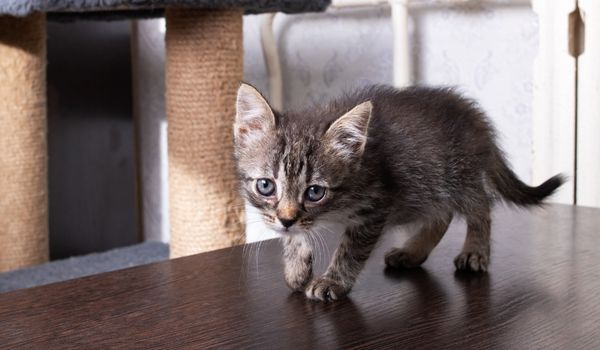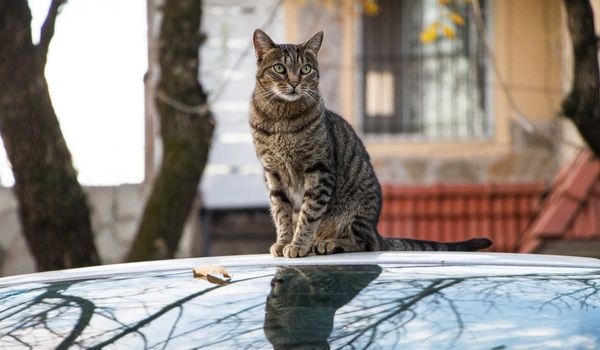Domestic Short-haired cats are the most ubiquitous in the United States and worldwide. The total population of Domestic Short-haired cats in America is around 80 million. In fact, most cats wandering around your neighborhood and kept as pets in American homes are Domestic Short-haired cats.
Given that Domestic Short-haired cats are low maintenance, friendly with kids and other pets, and come in various colors and patterns, it is no wonder that they are kept as pets in most homes in the U.S.
Origin of Domestic Short-Haired Cats
Often referred to as “Moggie,” a Domestic Shorthair cat is a cross of multiple cat breeds. Every cat that has a mixed origin (cannot be attributed to any particular cat breed) and a short-haired coat is considered a Domestic Short-haired cat (DSH). Because of their mixed origin, they are also lovingly called “mutts” of the feline world.
If you are looking to get yourself a Domestic Short-haired cat, keep on reading. In this article, we will cover everything you need to know about a Domestic Short-haired Cat.
Let’s begin with a brief overview of the breed.
Breed Overview
Domestic Short-haired cats comprise a major portion of the feline population not only in the United States but also in the world. They are a mix of many different cat breeds with no defined origin. On average, a Domestic Short-haired cat lives between 15 to 20 years, but if you take great care of your Domestic Shorthair cat, she can live well into her 20s.
The average weight of a healthy Domestic Short-haired cat should range between 12 to 15 pounds. These are highly affectionate cats out there. They easily get along with children, seniors, and other pets—both dogs and cats.
Key Features
Origin: Mixed
Weight: 12 to 15 pounds
Lifespan: 15 to 20 years
Coat Color: Litany of shades and patterns
Suitable for: First-time cat parents
Temperament: Highly affectionate, friendly, and playful
History of Domestic Short-Haired Cats
The roots of this versatile cat breed can be traced back to the 16th century. Many believe Domestic Short-haired cats first came to the New World—America—with settlers boarding the Mayflower ship. In those times, Domestic Short-haired cats were employed as rat catchers. In fact, settlers brought them to America so that they did not have to worry about rodents and rats destroying their food stashes on voyages.
After they arrived in Plymouth, they spread across Massachusetts. As a result of their crossbreeding with native cats, they multiplied and underwent many changes. This is why we see many types of Domestic Shorthair cats in different colors.
Is Domestic Short-Haired Cat the Same as the American Shorthair or British Shorthair?
Quite often, we confuse a Domestic Short-haired cat with an American Shorthair or a British Shorthair, but they are not the same. American Shorthair and British Shorthair are two separate cat breeds with unique genetic makeup.
Unlike Domestic Short-haired cats, American and British Shorthair cats were selectively bred to get the most desired characteristics—coat length, colorings, and markings—in cats. However, the former owe their existence to Domestic Short-haired cats that were brought to the New World by the British settlers.
Types of Domestic Shorthair Cat
Because Domestic Short-haired cats are the offspring of many different cat breeds, they come in endless color combinations, markings, and eye colors. Below, we have discussed some of the Domestic Short-haired cats’ most popular color patterns.
Domestic Shorthair Tabby
Tabby is not a cat breed but rather a coat pattern. Tabby coat patterns are found in many cat breeds with stripes, such as Toyger, Bengal cat, European Shorthair, and American Shorthair, etc.
Domestic Shorthair Tabby cats have capital M markings on their foreheads. Similarly, mackerel tabby cats have rings on their chest, legs, and tails. Some Domestic Short-haired tabby cats have spotted coats.
Domestic Shorthair Black Cat
Like American Shorthair and British Shorthair, Domestic Shorthair cats also come with a black coat. Domestic Shorthair Black Cat has a pure black or smoky grey color coat.
Domestic Shorthair Calico
Domestic Shorthair calico cats have patches of different colors—black, white, orange—scattered all over their coats. An interesting fact about calico cats is that most of them are females—male calico cats are super rare. This is because this charming coloring pattern is associated with the X chromosome.
Where to Get a Domestic Shorthair Kitten?
Are you looking for a Domestic Shorthair kitten? Well, you have made a great choice. Domestic Shorthair cats are among the lowest maintenance cats, making them excellent family pets as they get along with children very well. But where are you going to get your Domestic Shorthair kitten from? From a nearby pet store?
Try not to buy a Domestic Shorthair cat from a pet store or anywhere else. Instead, it would be best if you adopted a Domestic Shorthair kitten from a nearby cat shelter. Hundreds of Domestic Shorthair cats are roaming around on the roads, and many others are waiting in shelters for loving cat parents like you to adopt them.
While considering Domestic Shorthair cat adoption, you should keep in mind that adopting a cat from the shelter does not mean that you will be getting a mangy cat. In fact, many of the cats at shelters are left there by cat parents who just can’t take care of the kittens.
Adopt and provide a sweet home and loads of love that these cute little fur balls deserve. If you are not sure about adoption, you can try fostering a kitten first.
How Much Does a Domestic Short-Haired Cat cost?
Where buying a rare cat breed might break your bank, adopting a Domestic Shorthair cat is the cheapest—you can head down to the nearest cat shelter and adopt one by simply paying for the paperwork. You can check out the ASPCA shelter to find yourself a purr-fect feline friend.
While picking up the cat from the shelter, take a cat carrier with you. You are also advised to directly take the adopted cat or kitten to a vet to get her examined and vaccinated. You should also get your cat spayed or neutered. This will not only keep your cat from developing bad behaviors like marking territories and nighttime yowling but will also help cut down the Domestic Shorthair cat population and the risk of your cat developing ovarian or testicle cancer.
Domestic Short-Haired Cat Health
Compared to most cat breeds, Domestic Short-haired cats are healthy. Their mixed genetic makeup from multiple parent breeds has probably made them this strong. However, a Domestic Shorthair cat may still face several minor health issues such as vomiting, urinary tract infection, and weight issues. Additionally, a Domestic Short-haired cat may also develop some serious feline illnesses, such as hyperthyroidism, diabetes, and respiratory and kidney issues.
But you need not worry about these health issues while adopting a Domestic Short-haired cat, as these health issues can easily be resolved. You just have to stay observant of any signs of sickness that your cat may exhibit. With timely care, you can make sure that your cat lives a healthy life.
Food and Diet Requirements of a Domestic Short-Haired Cat
Domestic Short-haired cats are prone to overeating—and thus, growing obese. Therefore, if you are not careful about the caloric intake of your Domestic Short-haired cat, she may grow overweight and obese, which leads to the development of many health issues like diabetes, joint pain, and cardiac illnesses.
If you do not want your cat to grow obese and develop related health issues, mind what you are putting in your cat’s bowl—the food should cater to its nutritional requirements. Similarly, if you want to spoil your cat with delicious treats, you should get some healthy cat treats.
Domestic Short-haired Cat Shedding
Domestic Short-haired cats shed quite less than long-haired cats and many exotic short-haired cat breeds. You can further minimize the shedding by brushing them from time to time—brushing once or twice a week would be enough. However, you can do more brushing with a comfy cat brush to strengthen your bond with your cat and keep your cat’s coat shining all the time.
Regular brushing will also help you discover early if your cat has fleas or ticks. If you find any sign of fleas on your cat, you should take immediate action and try some of the most effective home remedies to get rid of fleas on kittens. If these home remedies do not work for your cat, you should take her to a vet.
Some Fun Facts About Domestic Short-haired Cats
Now that you are adopting a Domestic Shorthair cat, you should know some of the most interesting facts about them.
- Given their low-maintenance and robust nature, they make an ideal first-time pet.
- They love to chase and hunt anything that is moving. You can get them a cat window perch, as they love to stalk birds flying outside.
- They are prone to overeating. Be careful about their caloric intake.
- Domestic Short-hair cats are the most common cats roaming in neighborhoods or found in shelters.
- These come in a wide variety of colors and patterns.
- They have medium-length tails and round paws.
- They are close cousins of both British Short-haired and American Short-haired cat breeds.

